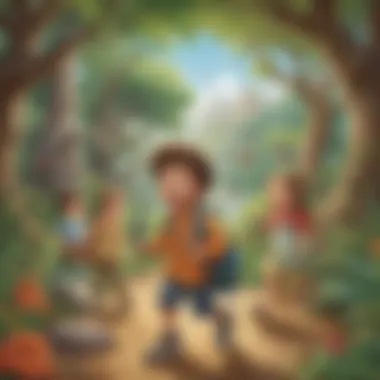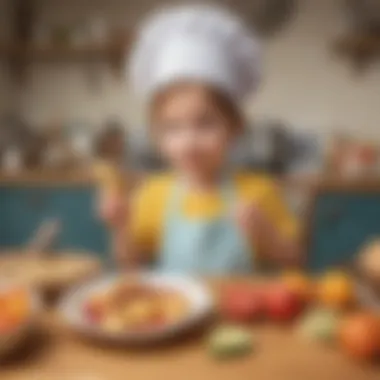Engaging Five Senses Activities to Stimulate Kindergarten Learning


Fun Activities Ideas
Indoor Activities
In the realm of indoor activities for kindergarteners to engage their sensory faculties, consider setting up sensory bins filled with various textures such as rice, dried beans, or sand. These tactile experiences help develop tactile perception and fine motor skills. Additionally, organizing a 'sensory walk' indoors where children touch and feel different surfaces like fluffy pillows, smooth stones, or rough fabric can stimulate their sense of touch.
Outdoor Adventures
Venturing outdoors opens up a realm of sensory exploration for kindergarten children. Activities like nature scavenger hunts encourage kids to use their senses of sight, sound, smell, and touch to discover the wonders of the natural world. Engaging in barefoot sensory walks on grass, sand, and gravel can enhance tactile sensitivity, while listening exercises to identify various bird sounds can sharpen auditory perception.
Arts and Crafts
Exploring art and craft activities provide an excellent opportunity for kindergarteners to engage their sense of creativity and touch. Encourage children to finger paint, mold clay, or create sensory collages using various textured materials like yarn, paper scraps, and fabric swatches. These activities not only foster artistic expression but also stimulate tactile and visual senses.
Science Experiments
Introducing simple science experiments tailored for kindergarten children can ignite their sense of curiosity and exploration. Activities such as making homemade playdough to engage touch, conducting color-mixing experiments to stimulate vision, or exploring the sense of smell through aromatic jars filled with herbs or spices can offer a multi-sensory learning experience.
Cooking and Baking
Incorporating cooking and baking activities can provide a hands-on sensory experience for young learners. Guiding children in measuring ingredients, mixing batters, and smelling aromatic spices engages their senses of touch, taste, and smell. Additionally, involving kids in decorating cupcakes or cookies enhances their visual and tactile perception while fostering a love for culinary creativity.
Introduction to Five Senses Activities
In the realm of kindergarten education, the introduction to activities that stimulate the five senses holds critical significance. This meta-cognitive approach not only enhances sensory development but also cultivates a holistic learning experience for young minds. By immersing children in activities that engage all their senses, parents and educators can lay a solid foundation for comprehensive cognitive growth and understanding. Understanding the sensory input mechanisms and responses empowers children to interact effectively with their environment and peers.
Understanding the Importance of Sensory Development
Impact on Overall Development
The impact of sensory development on overall cognitive growth cannot be overstated. The ability to process sensory information proficiently is paramount in shaping children's perception of the world around them. By engaging in activities that target sensory stimulation, youngsters can refine their perceptual skills and hone their ability to interpret and respond to various stimuli effectively. This not only accelerates their cognitive development but also nurtures essential life skills such as problem-solving, communication, and emotional regulation. The pathway delineated by sensory development forms the nucleus of a child's cognitive framework and lays the groundwork for future learning endeavors.
Role in Cognitive Growth
Sensory development plays a pivotal role in fostering cognitive growth among kindergarten children. The interplay between sensory stimulation and cognitive functions manifests in heightened neural connectivity and cognitive flexibility. By integrating sensory experiences into the learning curriculum, educators can facilitate a multi-dimensional approach to cognitive development, wherein children harness their sensory perceptions to decipher complex concepts and engage in creative problem-solving. This symbiotic relationship between sensory development and cognitive growth not only enhances learning retention but also fortifies the neural pathways associated with memory, attention, and abstract reasoning.


Benefits of Engaging the Five Senses
Enhanced Learning Retention
The correlation between sensory engagement and learning retention is profound. By immersing children in activities that stimulate all five senses, educators can create a dynamic learning environment that fosters experiential learning and long-term memory consolidation. The multi-sensory input reinforces neural connections, facilitating better retention of academic content and practical skills. Through hands-on experiences that target visual, auditory, tactile, olfactory, and gustatory senses, children can internalize information more effectively, leading to enhanced academic performance and cognitive fluency.
Improved Motor Skills
Engaging the five senses not only enhances cognitive functions but also augments motor skills development in kindergarten children. Activities that involve manipulating different textures, shapes, and materials stimulate hand-eye coordination, fine motor skills, and spatial awareness. Through tactile exploration, youngsters refine their motor proficiency and dexterity, laying a robust foundation for handwriting, drawing, and other fine motor tasks. The synergy between sensory engagement and motor skill development empowers children to navigate physical challenges with precision and confidence, enriching their overall sensory-motor integration.
Sight (Visual) Activities
Visual activities play a crucial role in stimulating a child's sense of sight. In this article, we focus on engaging kindergarten children through various visual experiences to aid in their sensory development. By exploring colors through art and engaging in visual scavenger hunts, children can enhance their observation skills and cognitive abilities. These activities not only support the development of visual perception but also promote creativity and critical thinking.
Exploring Colors Through Art
Within the realm of visual activities, exploring colors through art opens up a world of creative expression for children. Finger painting, as a specific aspect of this exploration, allows children to engage with colors on a tactile level. The tactile experience of finger painting enhances sensory integration and fine motor skills development. This hands-on approach stimulates the visual senses while encouraging self-expression and creativity. Finger painting stands out as a popular choice in this article due to its multisensory benefits and unique ability to engage children of varying abilities.
Finger Painting
Finger painting offers children the opportunity to blend colors, experiment with textures, and create visually appealing artwork using their hands. This hands-on activity promotes sensory exploration, hand-eye coordination, and cognitive development. Its fluid nature allows for unrestricted creativity, fostering a sense of freedom and self-expression in children. While finger painting can be messy, the tactile experience it provides outweighs any cleanup concerns, making it a valuable addition to sensory development activities for kindergarteners.
Color Sorting Games
Another engaging activity to explore colors is through color sorting games. By categorizing objects by color, children develop visual discrimination skills and color recognition. Color sorting games promote cognitive processing, problem-solving, and attention to detail. This activity encourages children to think critically, analyze information, and make decisions based on visual cues. Color sorting games offer a structured approach to color exploration, enhancing children's organizational skills and logical thinking abilities.
Visual Scavenger Hunts
Visual scavenger hunts add an element of adventure to sensory development activities. Nature scavenger hunts involve exploring outdoor environments, identifying objects based on visual cues, and connecting with nature. This activity enhances visual perceptual skills, spatial awareness, and sensory integration. In contrast, indoor object search challenges children to observe, identify, and locate specific items within an indoor setting. This task sharpens visual discrimination abilities, attention to detail, and memory recall. Visual scavenger hunts provide an interactive and engaging way for children to apply their visual skills in real-world contexts.
Nature Scavenger Hunt
Nature scavenger hunts immerse children in natural surroundings, encouraging them to appreciate the beauty of the outdoors while honing their visual observation skills. Participants learn to identify plants, animals, textures, and colors in their environment. Nature scavenger hunts promote environmental awareness, curiosity, and exploration. This activity instills a sense of wonder and respect for nature while fostering a deep connection to the natural world.
Indoor Object Search
Indoor object searches challenge children to observe familiar indoor spaces with a keen eye for detail. By locating and identifying specific items, children sharpen their visual memory, concentration, and problem-solving skills. Indoor object search activities promote visual scanning, focus, and attention to detail in a controlled indoor setting. This task encourages children to be observant, patient, and systematic in their search efforts, enhancing their visual perception and cognitive abilities.


Hearing (Auditory) Activities
Sound Exploration with Instruments
DIY Shaker Instruments
When it comes to DIY Shaker Instruments, these homemade musical tools offer a hands-on approach to sound exploration. Children can create their own shakers using simple materials like rice, beans, or beads sealed in containers. These instruments not only encourage creativity and fine motor skills but also expose children to different sounds and rhythms, fostering their auditory perception and sensory integration. The DIY aspect allows for customization and experimentation, making it a versatile choice for auditory activities in this context.
Musical Sensory Trays
Musical Sensory Trays introduce children to a multi-sensory experience by combining auditory stimulation with tactile exploration. These trays typically feature a variety of musical instruments or objects that produce different sounds when touched or manipulated. By engaging with these trays, children not only develop an appreciation for sound but also refine their motor skills and hand-eye coordination. The unique feature of Musical Sensory Trays lies in their ability to cater to different learning styles and sensory preferences, providing a holistic approach to sensory development in kindergarten.
Listening to Nature's Symphony
Exploring the natural world through sound is a captivating experience for kindergarten children. Birdsong Identification activities involve recognizing and imitating bird calls, enhancing auditory discrimination and nature appreciation. By engaging in outdoor Sound Mapping, children can listen attentively to the sounds of their environment, identifying various sources and understanding spatial acoustic patterns. These activities not only foster a connection to the natural world but also promote active listening skills and sound localization, enriching the auditory sensory experience for young learners.
Taste (Gustatory) Activities
In the realm of early childhood education, engaging kindergarteners in Taste (Gustatory) Activities holds significant importance. These activities not only serve as a fun and interactive way for children to explore their sense of taste but also play a pivotal role in enhancing their sensory development. By incorporating Taste (Gustatory) Activities into a child's learning journey, parents and educators can create a well-rounded experience that stimulates cognitive growth and enriches their overall development. It is essential to understand the specific benefits and considerations associated with these activities to maximize their effectiveness.
Flavorful Taste Tests
Sweet vs. Sour Challenge
The Sweet vs. Sour Challenge within Taste (Gustatory) Activities offers a unique opportunity for children to discern between different taste profiles. This activity encourages children to identify and differentiate between sweet and sour flavors, stimulating their taste buds and sensory perceptions. The contrasting elements of sweetness and sourness provide a sensory exploration that can enhance the child's palate and cognitive understanding of taste variations. The Sweet vs. Sour Challenge stands out as a popular choice within this article due to its ability to engage children actively while reinforcing their gustatory senses. Its interactive nature and clear distinctions between tastes make it a beneficial tool for sensory development in kindergarteners.
Healthy Snack Sampling
Healthy Snack Sampling, a key component of Taste (Gustatory) Activities, introduces children to a variety of nutritious food options while promoting healthy eating habits. Through this activity, children have the opportunity to taste and evaluate different snacks, fostering a positive relationship with healthy foods. Healthy Snack Sampling not only broadens a child's palate but also educates them about the importance of nutrition and making wholesome food choices. This activity's focus on promoting well-being and good eating habits aligns seamlessly with the goal of this article, which aims to enhance sensory development and provide enriching experiences for kindergarteners.
Cooking Adventures
Cooking Adventures serve as a hands-on and engaging way to involve children in the culinary world, promoting creativity and practical skills. Simple Recipes for Kids offer a gateway for children to explore basic cooking techniques and ingredient combinations in a playful and educational setting. This activity not only enhances children's gustatory experiences but also cultivates their fine motor skills and cognitive abilities. The appeal of Simple Recipes for Kids lies in its approachable nature and the opportunity it provides for children to express themselves through cooking. Integrating this activity into the learning environment can deepen a child's understanding of flavors and ingredients while fostering independence and creativity.
Ingredient Tasting Station


The Ingredient Tasting Station enhances children's sensory exploration by allowing them to experiment with various ingredients and flavors. This activity encourages children to engage all their senses by tasting, smelling, and touching different food components. Through the Ingredient Tasting Station, children can develop a nuanced understanding of how different ingredients contribute to overall flavor profiles, promoting sensory awareness and culinary curiosity. The interactive and multisensory nature of this activity ensures that children not only expand their taste preferences but also gain valuable insights into the world of food and cooking. Integrating the Ingredient Tasting Station into this article adds a rich and immersive dimension to the Gustatory Activities section, emphasizing hands-on experiences and experiential learning.
Smell (Olfactory) Activities
Aromatic Sensory Play
Herb Garden Exploration
Discovering the realm of herb garden exploration adds a unique dimension to the olfactory experience for kindergarten children. By immersing themselves in the scents of various herbs like lavender, mint, and rosemary, kids not only engage their sense of smell but also learn about different plant varieties and their characteristic fragrances. Herb garden exploration nurtures an appreciation for nature and plants, enhancing children's sensory perception and fostering a connection to the environment.
Scented Playdough Creations
Scented playdough creations offer a multisensory experience, combining the tactile elements of playdough with engaging scents. Children can explore different scents like vanilla, lemon, or cinnamon while molding and shaping the playdough, stimulating their olfactory senses and creative expression simultaneously. The incorporation of scents in playdough helps in relaxation, concentration, and sensory stimulation, making it a popular choice for sensory play activities in kindergarten settings.
Scented Storytime
Book Reading with Scented Markers
Integrating scents into storytime through the use of scented markers elevates the storytelling experience for young learners. As children follow along with a scented marker tracing the words or illustrations in a book, they not only engage visually but also olfactorily. Scented markers add an extra layer of sensory delight, making the reading experience more immersive and memorable for children. It enhances their focus, imagination, and association of scents with storytelling.
Essential Oil Diffuser Activities
Bringing essential oil diffuser activities into the realm of kindergarten sensory play introduces children to a variety of captivating scents like lavender, eucalyptus, or citrus blends. The diffusion of essential oils not only creates a sensory-rich environment but also promotes relaxation, concentration, and emotional well-being among young learners. Essential oil diffuser activities can be tailored to different themes or stories, adding a dimension of sensory exploration and emotional connection to the learning environment.
Touch (Tactile) Activities
Touch (Tactile) Activities are of paramount importance in this article as they play a significant role in enhancing sensory development and providing a hands-on learning experience for kindergarten children. By incorporating activities that focus on tactile sensations, young learners can explore various textures, shapes, and materials, stimulating their senses and promoting cognitive development. The tactile sense allows children to learn about their environment through touch, aiding in the development of fine motor skills and enhancing their overall sensory perception.
Texture Exploration
When it comes to Texture Exploration, one engaging aspect to consider is the use of Sensory Bins with Various Materials. These bins are filled with a mix of textures like sand, rice, beans, or water beads, providing children with a tactile sensory experience that encourages sensory exploration and imaginative play. The key characteristic of Sensory Bins lies in their versatility, allowing for different textures to be combined to create a unique sensory experience. They are a popular choice for this article due to their ability to engage multiple senses simultaneously and promote sensory integration. However, one consideration to note is the potential messiness associated with sensory bins, requiring adequate supervision and cleanup routines to ensure a safe and enjoyable experience for children.
Fabric Swatch Matching
Another intriguing activity within Tactile Activities is Fabric Swatch Matching, which focuses on exploring different fabrics by matching them based on texture. This activity contributes to the overall goal of sensory stimulation by introducing children to various tactile sensations and improving their tactile discrimination skills. The key characteristic of Fabric Swatch Matching is its simplicity yet effectiveness in helping children differentiate between different textures through hands-on exploration. It is a beneficial choice for this article as it encourages sensory awareness and fine motor skills development through a fun and interactive activity. One advantage of Fabric Swatch Matching is its adaptability for children with sensory processing sensitivities, as it allows for gentle exposure to different textures in a controlled setting.
Tactile Art Projects
Moving on to Tactile Art Projects, one creative aspect to explore is DIY Sensory Boards. These boards are designed to engage children in tactile exploration by incorporating various materials such as fabrics, buttons, and textures for sensory-rich experiences. The key characteristic of DIY Sensory Boards is their versatility, allowing for customization based on individual preferences and sensory needs. They are a popular choice for this article as they combine artistic expression with sensory stimulation, promoting creativity and sensorimotor development. An advantage of DIY Sensory Boards is their capability to cater to diverse sensory preferences and provide children with a multisensory art experience that enhances their tactile sensitivity and cognitive skills.
Kinetic Sand Sculpting
Lastly, Kinetic Sand Sculpting is an intriguing tactile activity that involves shaping and molding kinetic sand to create unique designs and structures. This activity contributes to the overarching goal of sensory engagement by offering children a hands-on experience with a moldable, sensory-rich material. The key characteristic of Kinetic Sand Sculpting is its therapeutic benefits in promoting relaxation and tactile exploration. It is a beneficial choice for this article as it encourages fine motor skill development and sensory integration through sensory play. One advantage of Kinetic Sand Sculpting is its mess-free nature compared to traditional sand, making it a convenient and enjoyable tactile activity for children to explore and create tactile masterpieces.



